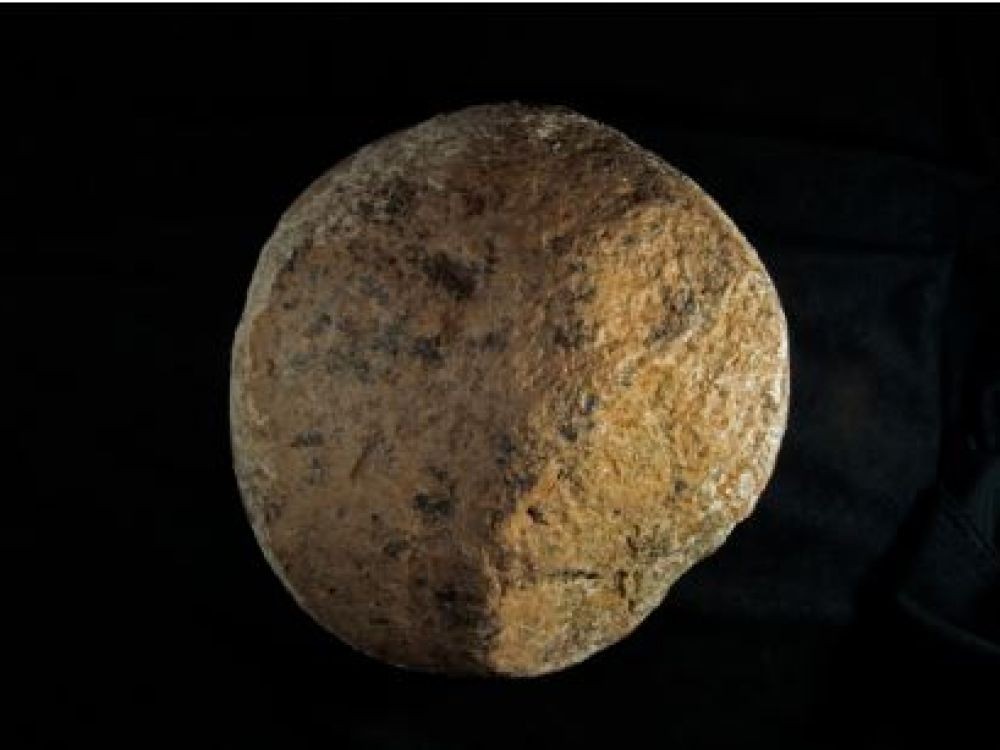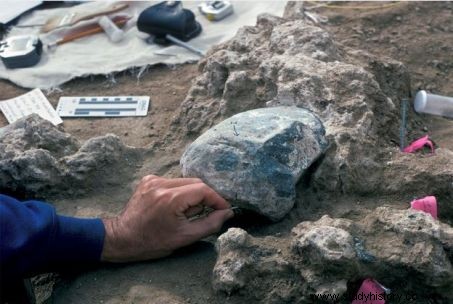Bones of a mastodon, a now-extinct ancestor of the elephant, suggest that humans arrived in America 100,000 years earlier than previously thought.

This pebble unearthed in San Diego (California) could have been used by humans to break mastodon bones, 130,000 years ago.
Human presence on the American continent is 115,000 years older than previously thought! This is the "explosive" news announced by scientists on Wednesday, April 26, 2017, inviting us to rethink the history of the settlement of the New World. "The remains we have found in California suggest an early occupation as early as 130,000 years ago “, explains Judy Gradwohl, president of the San Diego Museum of Natural History, the establishment that piloted the study published in the journal Nature . The American-Australian research team claims to have succeeded in dating stone tools and bones of a mastodon (Mammuth americanum ), an ancestor of the now extinct elephant, which they believe bears the marks of human intervention. "Bones and several teeth are clear evidence that humans purposely broke them using skill and experience “, says Steve Holen, co-author of the study. So many elements that immediately triggered a wave of reactions among specialists where the subject is particularly sensitive.

A researcher holds a mastodon bone fragment found under a stone anvil discovered at the California site © SDNHM
Anthropologists and archaeologists are indeed divided on the origins of the settlement of the American continent. When did the first humans arrive? Where and how? Opinions diverge and theories are regularly challenged. Until now, the dominant thesis was that the first humans - Homo sapiens - to set foot in the New World arrived from Asia around 14,500 years ago. A dogma periodically challenged, older datings being regularly published. Whether in South America, with archaeological sites over 30,000 years old (Brazil, Chile) or in North America with the site of Hot Springs (South Dakota) or that of Blue Fish Cave (Canada) where recent announcements evoked a human presence at 24,000 years ago. Scientists argue that colonization could have been done inland by taking a 1,500 km long corridor, which then connected Eastern Siberia to the North American continent, partly drowned today under the Bering Strait. . Other researchers suggest an arrival along the Pacific from Alaska, on foot or by sea. But according to this new study, these men who arrived from Asia would not be the first "Americans". This does not surprise the prehistorian Eric Boeda, specialist in the lithic industry at the University of Paris-X Nanterre and quoted by "Le Monde". After the pioneering work in Brazil of the Frenchwoman Niède Guidon, to whom he succeeded, the new director of the Franco-Brazilian archaeological mission believes that "tongues are loosened and dogmas fall with this post "Perfectly Compelling .
Dating techniques
The remains of the "Cerutti Mastodon Site" in California studied by the authors of this new study were found 25 years ago (1992). But it was only recently, through the uranium-thorium dating method measuring the relative levels of radioactive uranium and thorium applied to these bones, that they were able to make them "talk." "Dating technologies have advanced and now allow us to say with greater certainty that early humans were here much earlier than commonly believed “, says in a press release Thomas Demere, paleontologist from the San Diego Natural History Museum, also co-author of the study. A publication hailed by Alistair Pike, specialist in U-Th radiometric dating at the University of Southampton (Grande -Bretagne) who told Nature that "these results are as good as possible ". But who were these first occupants of the American continent? Probably not Homo Sapiens, modern man, since the latter is supposed to have left Africa only about 100.00 years ago. For the researchers, it is rather one of his extinct cousins, Homo erectus, Neanderthals or even Denisovans... Since the scientists did not find any traces of DNA on the site, the family to which these belong hominids, probably extinct according to researchers, remains a mystery. "The founding populations of Americans could be very diverse “, estimated, in a commentary accompanying the study, Erella Hovers, of the Hebrew University of Jerusalem (Israel).
with AFP
